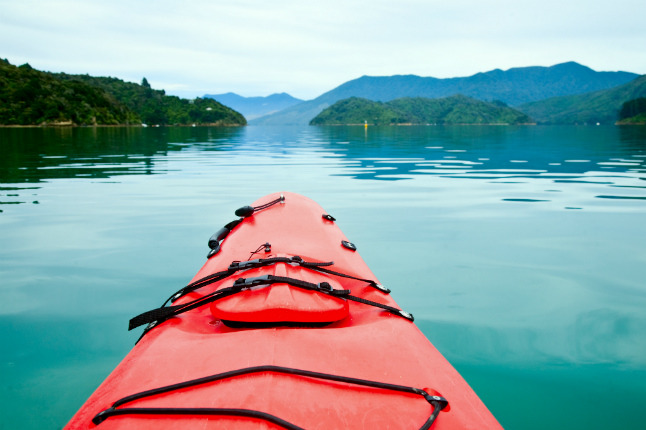6 Expert Tips For Beginner Sea Kayakers
Kayaking has been described as anywhere from serene to extreme. Whether calming or adventurous in nature, your experience becomes even bigger when paddling in ocean water. Cathy Piffath, a certified kayak instructor for over 20 years and the creator of the American Canoe Association's Coastal Kayak Program, has six tips to paddle by for newcomers to the sea.
1. Take a Lesson.
You have to start somewhere. With sea kayaking, it's best to pick up fundamental skills before dipping your paddle in the big drink. "I think it's important that beginners take a lesson," says Piffath. "If you don't have the skills—like going from paddling strokes to maneuvering capabilities, for instance—then you run into trouble." Outfitters up and down both coasts offer simple lessons, as well as more intensive courses, to start you down the path to a paddling pro.
2. Know the Basics.
Though it seems pretty straightforward—stick your paddle in the water and pull—Piffath says there are a lot of sea kayaking "basics" that first-timers tend to flub. Here's a quick cheat sheet of standard techniques so you can get it right the first time:
• Hold the paddle with a light grip. This allows you to control your kayak's movements while staying flexible and cutting down on your chances of straining a muscle.
• Swift, rhythmic and deep forward paddling will really make your boat go.
• Sweep strokes are corrective and can help you maneuver––these should be wider than your forward strokes and reversed, depending on the turn you'd like to make.
• Do what works for you: sticking to your own style (range, pace, etc.) of paddling is encouraged if you feel comfortable doing so, and will allow you to move more naturally on the water.
• Most importantly, keep your upper body at a balanced center of gravity (hint: keep your nose aligned with the center of the boat and pointing forward). When balanced, tipping is nearly impossible and steering becomes much easier. Rocking your hips while staying centered will demonstrate how much movement the kayak will allow you to have (which is quite a bit).
3. Practice the Basics.
Practice makes perfect, especially when it comes to sea kayaking. You actually don't want to start in the water, though. Piffath begins each one of her lessons by practicing proper techniques on the beach first, for muscle memory. After repeating strokes on land, take to shallow, calm water to make sure you've got everything down. If the boat is moving efficiently and you feel comfortable and confident in your paddling, step it up by heading to more open waters with your group. "If you have good forward strokes, good sweep strokes and good corrective strokes, you can get yourself out of any situation that arises," says Piffath.
...including the all-important "wet release."
Still, when you're new anything can happen––like flipping over. If you do tip and wind up underwater, complete this four-step process to free yourself from the boat:
• Lean forward
• Push the bottom of the boat with your paddle
• Release the protective (but now constraining) spray skirt that ties you into the boat
• Make sure the skirt is all the way off, and push out of the boat
All of that can be a lot to remember when you're in a panicked state, with your head submerged in cold saltwater. Not to worry, as Piffath says, "The number one thing to keep in mind is that, if you go upside down, gravity rules." In other words, you're likely to automatically propel out of the boat, and rise towards the surface in most circumstances.
4. Pick Your Route and Check the Weather.
Piffath recommends being familiar with the area where you'd like to paddle, keeping in mind that bays and other sheltered areas, protected from the strongers winds and choppier waters of the open sea, are best for beginners. Check a marine forecast to get a general idea of what the weather might do on the water, but always expect some wind and waves, even on a beautiful, bluebird day. Avoid fog as much as possible. "Fog is a real issue, and can come in real quickly," Piffath says. "Visibility can be lost within five to 10 minutes––you could lose sight completely of your land, and that's a scary thing."
5. Bring a Map.
Your GPS and iPhone or Android are great tools to bring paddling (try the Lifeproof case for sleek, top-notch waterproofing), but they're only as good as their battery life or, as is often a problem on the ocean, their reception signal. "Knowing how to read a [nautical] chart and use a compass is huge," says Piffath. Remembering to pack them is even bigger.
6. Bring a Friend (or Four).
Kayaking alone is never a good idea, and it's even worse when you're a newbie. Understand now that the ocean is big, powerful and pretty darn unpredictable, but it doesn't have to be scary. The more companions you bring paddling, the safer (and probably more fun) your voyage will be. "Go with a veteran group," says Piffath. "If you can experience the wide variety of conditions that'll affect your kayak with a veteran group of guides the first time around, you'll gain invaluable experience from it."
Cathy Piffath is also the Co-Founder and "Head Honcho" of H2Outffiters Sea Kayaking Adventures in Orr's Island, Maine.
